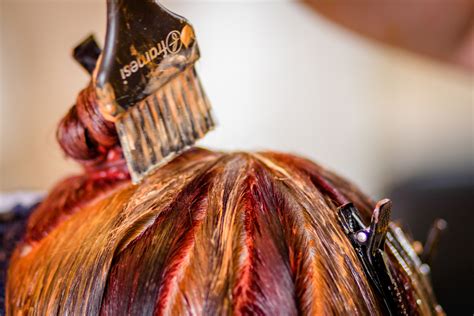Introduction
Hair color application has become a ubiquitous practice in modern society, with countless individuals seeking to enhance their appearance, express their individuality, or simply cover up gray hairs. The global hair color market is projected to reach $30.91 billion by 2027, driven by factors such as rising disposable income, increasing awareness of hair care trends, and the growing popularity of home hair coloring kits.

Types of Hair Color Applications
- Permanent Hair Color: Permanently alters the hair’s natural pigment, lasting up to 8-10 weeks.
- Semi-Permanent Hair Color: Gradually fades over time, typically lasting 4-6 weeks.
- Demi-Permanent Hair Color: A hybrid between permanent and semi-permanent, lasting up to 8 weeks.
- Temporary Hair Color: Washes out after one or two washes.
- Root Touch-Up: Conceals gray roots without fully coloring the entire head.
- Balayage: A freehand technique that creates natural-looking highlights and lowlights.
- Ombré: A gradual blend of two or more hair colors, typically from dark to light.
- Foiliage: Hair is wrapped in foil, then color is applied for a precise, highlighted effect.
- Fashion Color: Bold and unconventional shades, such as pastel, neon, or metallic.
Benefits of Hair Color Application
- Appearance Enhancement: Transforms hair color to desired shade, enhancing overall appearance.
- Increased Confidence: Boosts self-esteem and confidence by improving personal image.
- Expression of Individuality: Allows individuals to express their unique personality and style.
- Gray Hair Coverage: Conceals gray hairs, rejuvenating appearance.
- Trend Following: Enables adherence to latest hair color trends.
Common Mistakes to Avoid
- Overlapping Colors: Applying multiple colors too close together can result in muddy or uneven results.
- Excessive Bleaching: Excessive bleaching damages hair, leaving it dry, brittle, and prone to breakage.
- Ignoring Hair Texture: Different hair textures (e.g., fine or coarse) require specific application techniques.
- Using Wrong Color: Choosing a hair color that is too dark or too light for your skin tone can create an unflattering effect.
- Lack of Proper Care: Neglecting hair care after coloring can accelerate fading and damage.
Step-by-Step Hair Color Application
1. Preparation:
- Choose the desired hair color and application method.
- Gather necessary tools (e.g., brush, bowl, gloves).
- Protect clothing and work area with a cape.
- Perform a strand test to determine the desired color and timing.
2. Application:
- Divide hair into sections.
- Apply color according to the manufacturer’s instructions.
- Use a wide-tooth comb to distribute color evenly.
- Check timing regularly.
3. Rinsing:
- Rinse hair thoroughly with cool water until the water runs clear.
- Use a color-protecting conditioner to seal in color and protect hair.
4. Styling:
- Dry and style hair as usual.
- Use products specifically designed for color-treated hair.
Conclusion
Hair color application offers endless possibilities for personal expression and appearance enhancement. By understanding different application methods, benefits, and potential mistakes, individuals can achieve the desired hair color transformation while maintaining healthy, vibrant locks. With the advent of new technology and color innovations, the future of hair color application holds even more exciting possibilities for limitless self-expression.
| Keyword | Description |
|---|---|
| Permanent Hair Color | Alters natural pigment, lasting up to 10 weeks |
| Demi-Permanent Hair Color | Hybrid of permanent and semi-permanent, lasting up to 8 weeks |
| Balayage | Freehand highlights and lowlights for natural effect |
| Gray Hair Coverage | Conceals gray roots, rejuvenating appearance |
| Color-Protecting Conditioner | Seals in color and protects treated hair |
| Technique | Description | Benefits |
|---|---|---|
| Permanent Color | Alters natural pigment, long-lasting | Covers gray, vibrant colors |
| Semi-Permanent Color | Fades over time, gentle on hair | Natural-looking, less damage |
| Demi-Permanent Color | Hybrid of permanent and semi-permanent | Gray coverage, less fading |
| Root Touch-Up | Conceals gray roots | Quick and easy, targeted application |
| Balayage | Freehand highlights and lowlights | Natural-looking, subtle dimension |
| Ombré | Gradual blend of two or more colors | Edgy, trend-setting |
| Foiliage | Precise highlighted effect | Vibrant colors, long-lasting |
| Trend | Description | Popularity |
|---|---|---|
| “Bronde” | Blend of brunette and blonde | Versatility, natural warmth |
| “Caramel Balayage” | Rich, caramel-toned highlights | Enhances brunette shades, adds dimension |
| “Mushroom Brown” | Ashy, metallic brown | Edgy, trendy |
| “Buttery Blonde” | Warm, golden blonde | Softens facial features, adds luminosity |
| “Copper Red” | Vibrant, reddish-orange | Bold, eye-catching |
| Term | Definition |
|---|---|
| Pigment | Natural chemical that gives hair its color |
| Developer | Chemical that activates hair color |
| Toner | Deposit color without altering natural pigment |
| Gray Coverage | Percentage of gray hair covered |
| Oxidation | Chemical process that changes hair color |
| Statistic | Source |
|---|---|
| 75% of women in the US color their hair | Statista, 2022 |
| Global hair color market projected to reach $30.91 billion by 2027 | Businesswire, 2023 |
| 5% of hair color applications are done by professionals | L’Oréal Professionnel, 2021 |
| 40% of women color their hair at least once a year | American Academy of Dermatology, 2022 |
